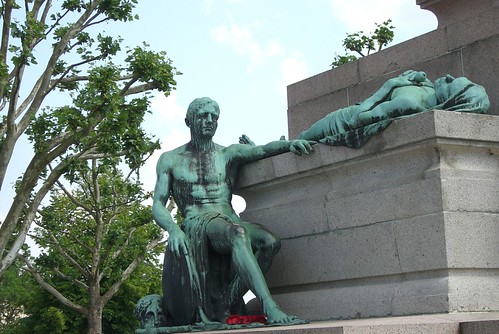And in the footsteps of JFK and Ronald Reagan (OK maybe we weren't THAT important), we made our way to Berlin. Unfortunately by the time we arrived, there was no wall left - I of course wanted my money back and a plane back to Brussels.
Coping with my disappointment, we made our way to the hostel in what was formerly East Berlin. We wandered through an alley and climbed the stairs up to our hostel, following the crooked signs for the THE HELTER SKELTER. Upon entering, one could not avoid the impending message on the hostel wall:
In dreadful anticipation, we moved into the next room to check in:
In reality, it wasn't as bad as it seems. But for those of you who remember the Christian hostel in Amsterdam (post is below!) going from "God's Mailbox" to skulls and bones is quite a shock. Helter Skelter even felt the need to put this warning up on the pool table:
The wall to the left in this picture is one of the longest stretches of the wall left:
We also visited the Brandenburg gate, formerly a gate between East and West, and the gate where Ronald Reagan gave his famous speech:
We saw the most famous checkpoint between East and West Berlin, Checkpoint Charlie:
While Berlin no longer has an area called the "American Sector" they have kept this sign at Checkpoint Charlie:
We saw the Reichstag, housing the German Parliament. We unfortunately couldn't get into the famous "Dome" so we decided to have a little bit of fun outside. The result were some ridiculous "jumping" pictures.
We also visited the museum, which was equally humbling.

This first picture is a map of SS headquarters and departments in Berlin during the war - including Communications, Recruitment, Military Planning.
This picture in the Gestapo Museum was taken in Brussels, only a short walk from my house. It shows prisoners being moved by SS guards.
We had a chance to visit some other historical museums, including the German history museum with artifacts going back to early civilizations:
One of the true gems in Berlin was the Pergamon Museum, which reconstructed some of the world's treasured monuments. This first picture is of the Pergamon Altar from the 2nd Century BC.
Pictures from "Museum Island" where most of the museums are located:
You can't go to Berlin without enjoying the food. I don't think I've eaten as much sausage in a 3 day period as I did in Berlin! And the choices are endless - bratwurst, currywurst, bockwurst - you name it they have it. We also enjoyed the nightlife - with a group that loves to have a lot of fun, we discovered another great side of Berlin.
And lastly the trip home! The seats here are heated, oddly enough. The vents are alll under the seats, causing it to rise up - certainly a strange metro ride. We woke up at 5 in the morning and had to navigate 3 trains and a shuttle bus to get to the airport, but we made it back to Brussels.





























































